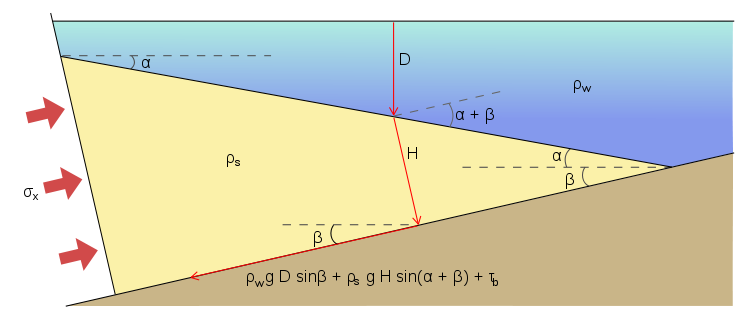How do mountains form? It’s just thrusts, right? Compression causes thrust faulting which piles up layers and layers of rock. This causes Barrovian metamorphism and makes mountains. Simple, no?
No.
Thrusting is important, of course, but as always real rocks are more complicated. For example, across the whole of the Himalayan chain, coincident with the highest peaks, is a structure called the South Tibetan Detachment system. It has a normal sense of shear, so it moves in the opposite sense to a thrust. Normal faults are associated with extension, not compression. To find something like this in the heart of a mountain belt caused by two plates colliding is extremely counter-intuitive.
So, a simple explanation (“its all thrusting”) is woefully inadequate. What more sophisticated models are there and how do they explain the South Tibetan Detachment?
Critical taper theory is a model that was originally developed for accretionary wedges.
I like to think of it in terms of a bulldozer pushing a pile of sand up a slope. The bulldozer (e.g. Japan) is scraping sand off the floor (Pacific plate). The sand deforms into a wedge, and reaches a stable shape with a particular angle between the slope and the surface of the wedge – the critical taper. This angle is controlled by the balance between movement of the sand on the floor (the ‘basal décollement’ at the top of the oceanic plate) and deformation within the wedge itself.
The wedge is a dynamic system. If something changes (like material being eroded off the top) then the wedge will deform internally until the critical taper is reached.
Critical taper theory works well for accretionary wedges and has been has been modified and applied to mountains, usually using the name of orogenic wedge. Talking about the Himalayas once more, there is a structure that acts like a basal décollement called the Main Frontal Thrust. This is a feature found in many mountains belts so the concept of an orogenic wedge is a useful one.
There are many papers on this subject, but a classic of the genre is John Platt’s 1986 paper “Dynamics of wedges and uplift of high-pressure rocks” (available to us all via the man himself). It extends critical taper concepts to mountain belts such as the Alps or the Franciscan complex in California and addresses the more complex rheology of orogenic wedges (they are made up of viscous metamorphic rocks, not just cold rigid sediments). Its purpose is to explain how high-pressure rocks come to be at the surface within these wedges.
An orogenic wedge will thicken by thrusting, until it reaches its a stable geometry. If new material is added at the front of the wedge, then the wedge will shorten internally to regain a stable geometry. If new material is added underneath, to thicken the wedge, then it will extend internally. This extension within the wedge provides a mechanism to exhume high pressure rocks, to bring them to the surface via extension, even within a compressional orogen. Look at the John Platt paper for more explanation and some nice diagrams.
This is a neat trick and gives us a way to explain the South Tibetan Detachment system. The Himalayas are made-up of weak hot rocks piled up in a wedge between Tibet and the Main Frontal Thrust. They want to collapse down again, but they are kept up by the continuous movement of the Indian plate. This delicate balance has been disturbed in the past, meaning that there has been extension within the wedge, forming our normal faults. Problem solved?
For the sake of this post, perhaps yes, but I’ll leave you with a cliff-hanger. Extensional movement on the South Tibetan Detachment can in places be shown to the happening at the same time as thrusting structurally below. Wedge dynamics can’t explain this, it can only explain thrusting and extension at different times (when the wedge is too thin or too thick). Also think of the geometry of this. If you have an extensional fault above a thrust then the material in between is being squeezed out, like a soft filling in squashed sandwich. What fresh madness is this?
This post is part of my journey into the geology of mountains.
Image of tapir from http://www.northrup.org/photos/bairds-tapir/


terrific post! just a terminological observation:
Talking about the Himalayas once more, there is a structure that acts like a basal décollement called the Main Frontal Thrust.
the Main Frontal Thrust is the contact between the Neogene Siwaliks above the alluvium of the Indo-Gangetic depression. The theory is (as i understand) that it soles out along with the Main Boundary Thrust and the Main Central Thrust into a low angle crustal detachment fault or a basal decollement called the Main Himalayan Thrust or the Main Detachment Fault.. maddening number of thrusts!
Pingback: Channel flow – hot rocks, big glaciers and the world’s tallest mountains | Metageologist
I just couldn’t leave your web site before suggesting that I really enjoyed the usual info a person supply on your visitors? Is gonna be again incessantly in order to investigate cross-check new posts